Optimization of Magnetic Nozzle Configuration and Hybrid Propellant for Radio-Frequency Plasma Micro-Thrusters in Very Low Earth Orbit Applications
Abstract
1. Introduction
2. Operating Principle and Experimental Scheme
2.1. Operating Principle
2.2. Design and Experimental Scheme of Micro-Thruster
2.3. Experimental Facility
3. Results
3.1. The Qualitative Influence of Magnetic Nozzle Configuration on Plasma
3.2. Experimental Results and Analysis
3.2.1. Results and Analysis of Pure Aerodynamic Thrust
3.2.2. Results and Analysis of Pure Xenon Thrust
3.2.3. Results and Analysis of Mixed Propellant Thrust
4. Conclusions
- (1)
- Through research on pure xenon working medium, it has been verified that magnetic nozzles do indeed have significant confinement and acceleration effects, can effectively confine plasma, and form a distinct waistband effect.
- (2)
- It is feasible to implement an aspirating radio frequency plasma micro-thruster using Xe and air as the working medium, which can achieve stable plasma self-sustaining stable discharge.
- (3)
- Under an appropriate mixture ratio of xenon and air, the thrust can be significantly increased. Meanwhile, under higher radio frequency power conditions, the mixed working medium of xenon and air can provide a stronger thrust effect.
- (4)
- The achieved thrust-to-power ratio in mN/kW which appears to range from ≈18 at 60 W to ≈13 at 130 W.
Author Contributions
Funding
Data Availability Statement
Conflicts of Interest
References
- Kansakar, P.; Hossain, F. A review of applications of satellite earth observation data for global societal benefit and stewardship of planet earth. Space Policy 2016, 36, 46–54. [Google Scholar] [CrossRef]
- Llop, J.; Roberts, P.; Zhao, H. Very low Earth Orbit mission concepts for Earth observation: Benefits and challenges. In Proceedings of the Reinventing Space Conference 2014, London, UK, 18–21 November 2014. [Google Scholar]
- Charles, C. Plasmas for spacecraft propulsion. J. Phys. D Appl. Phys. 2009, 42, 163001. [Google Scholar] [CrossRef]
- Mcdowell, J. The low earth orbit satellite population and impacts of the Space X star link constellation. Astrophys. J. 2020, 892, L36. [Google Scholar] [CrossRef]
- Xia, G.; Li, H.; Ding, Y.; Wei, L.; Chen, S.; Yu, D. Performance optimization of a krypton hall thruster with a rotating propellant supply. Acta Astronaut 2020, 171, 290–299. [Google Scholar] [CrossRef]
- Saleh, J.H.; Geng, F.; Ku, M.; Walker, M.L., II. Electric propulsion reliability: Statistical analysis of on-orbit anomalies and comparative analysis of electric versus chemical propulsion failure rates. Acta Astronaut 2017, 139, 141–156. [Google Scholar] [CrossRef]
- Lev, D.; Myers, R.M.; Lemmer, K.M.; Kolbeck, J.; Koizumi, H.; Polzin, K. The technological and commercial expansion of electric propulsion. Acta Astronaut 2019, 159, 213–227. [Google Scholar] [CrossRef]
- Munro-O’Brien, T.F.; Ahmed, M.; Lucca Fabris, A.; Ryan, C.N. Inter-Laboratory Characterisation of a Low-Power Channel-Less Hall-Effect Thruster: Performance Comparisons and Lessons Learnt. Aerospace 2025, 12, 601. [Google Scholar] [CrossRef]
- Liu, Q.; Li, Y.; Hu, Y.; Mao, W. Effects of Magnetic Field Gradient on the Performance of a Magnetically Shielded Hall Thruster. Aerospace 2023, 10, 942. [Google Scholar] [CrossRef]
- Giannetti, V.; Saravia, M.M.; Leporini, L.; Camarri, S.; Andreussi, T. Numerical and Experimental Investigation of Longitudinal Oscillations in Hall Thrusters. Aerospace 2021, 8, 148. [Google Scholar] [CrossRef]
- Zheng, J.; Hu, H.; Huang, J.; Zhao, B.; Huang, H. CF-DeepONet: Deep operator neural networks for solving compressible flows. Aerosp. Sci. Technol. 2025, 163, 110329. [Google Scholar] [CrossRef]
- Doh, G.; Kim, Y.; Lee, D.; Park, J.; Choe, W. Development of a 700 W class laboratory model hall thruster. J. Korean Soc. Propuls. Eng. 2021, 25, 65–72. [Google Scholar] [CrossRef]
- Levchenko, I.; Goebel, D.; Bazaka, K. Electric propulsion of spacecraft. Phys. Today 2022, 75, 38–44. [Google Scholar] [CrossRef]
- Chen, F. Helicon discharges and sources: A review. Plasma Sources Sci. Technol. 2015, 24, 014001. [Google Scholar] [CrossRef]
- Takahashi, K.; Charles, C.; Boswell, R.; Ando, A. Effect of magnetic and physical nozzles on plasma thruster performance. Plasma Sources Sci. Technol. 2014, 23, 044004. [Google Scholar] [CrossRef]
- Sekine, H.; Koizumi, H.; Komurasaki, K. Measurement and Identification of Azimuthal Current in an RF Plasma Thruster Employing a Time-Varying Magnetic Field. AIP Adv. 2021, 11, 015102. [Google Scholar] [CrossRef]
- Sekine, H.; Koizumi, H.; Komurasaki, K. Electrostatic on Acceleration in an Inductive Radio-Frequency Plasma Thruster. Phys. Plasmas 2020, 27, 103513. [Google Scholar] [CrossRef]
- Kim, J.; Go, G.; Hwang, Y.; Chung, K.-J. Dependence of the Polytropic Index of Plasma on Magnetic Field. New J. Phys. 2021, 23, 052001. [Google Scholar] [CrossRef]
- Boni, F.; Jarrige, J.; Désangles, V. Plasma Expansion and Electron Properties in a Magnetic Nozzle Electrode less Thruster. In Proceedings of the International Electric Propulsion Conference, Boston, MA, USA, 19–13 June 2022. [Google Scholar]
- Boni, F.; Désangles, V.; Jarrige, J. Experimental Characterization of Thrust Production Mechanisms in a Magnetic Nozzle ECR Thruster. In Proceedings of the 37th International Electric Propulsion Conference, Boston, MA, USA, 19–13 June 2022. [Google Scholar]
- Chen, Z.; Wang, Y.; Ren, J.; Tang, H.; Wu, P.; Li, M. The Fully Kinetic Investigations on the lon Acceleration Mechanisms in an Electron-Driven Magnetic Nozzle. Plasma Sources Sci. Technol. 2022, 31, 055013. [Google Scholar] [CrossRef]
- Kokal, U.; Saridede, E.; Celik, M. Development and tests of a thrust stand with an in-situ null position adjustment and calibration method for low power plasma thrusters. Results Eng. 2023, 18, 101219. [Google Scholar] [CrossRef]
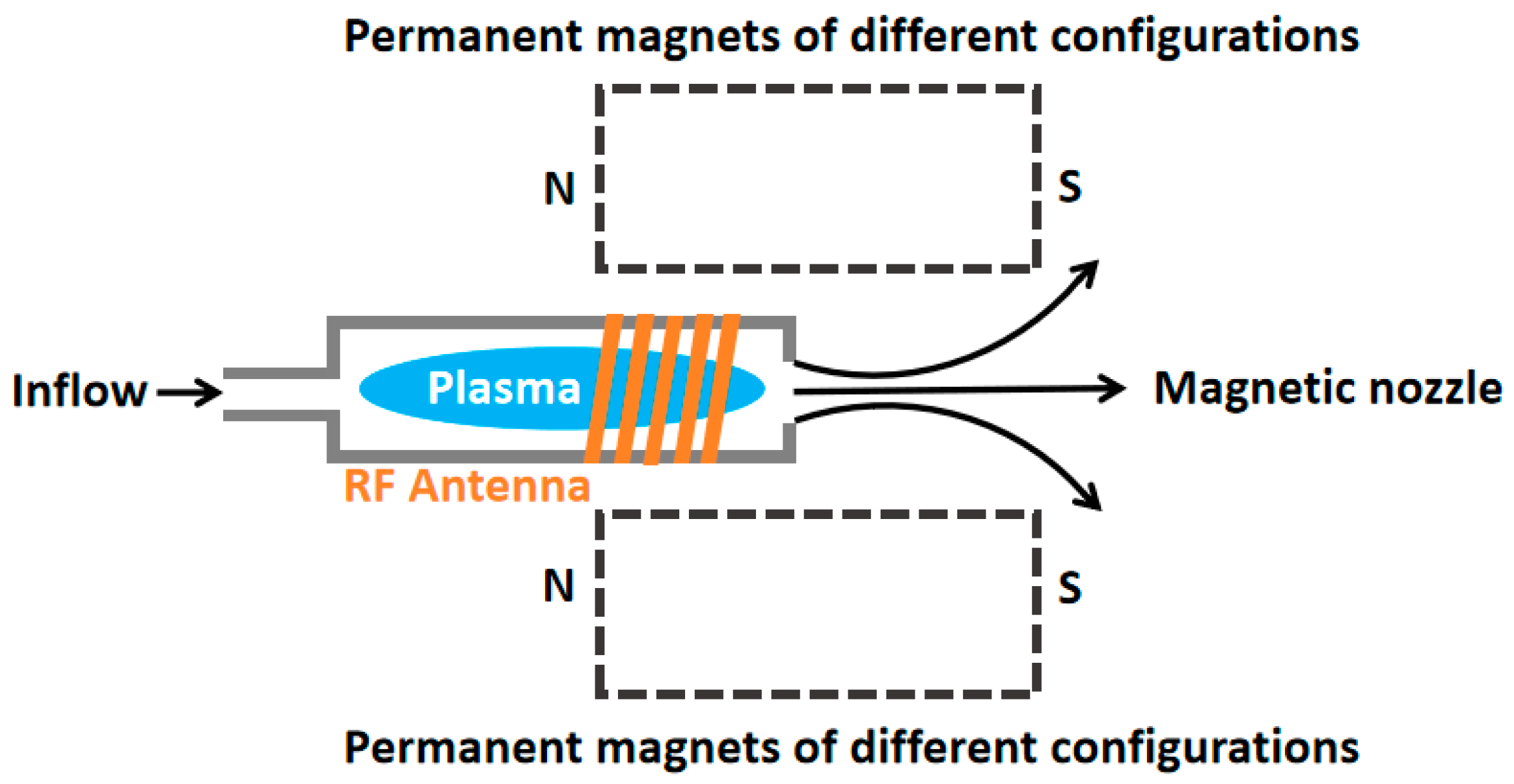
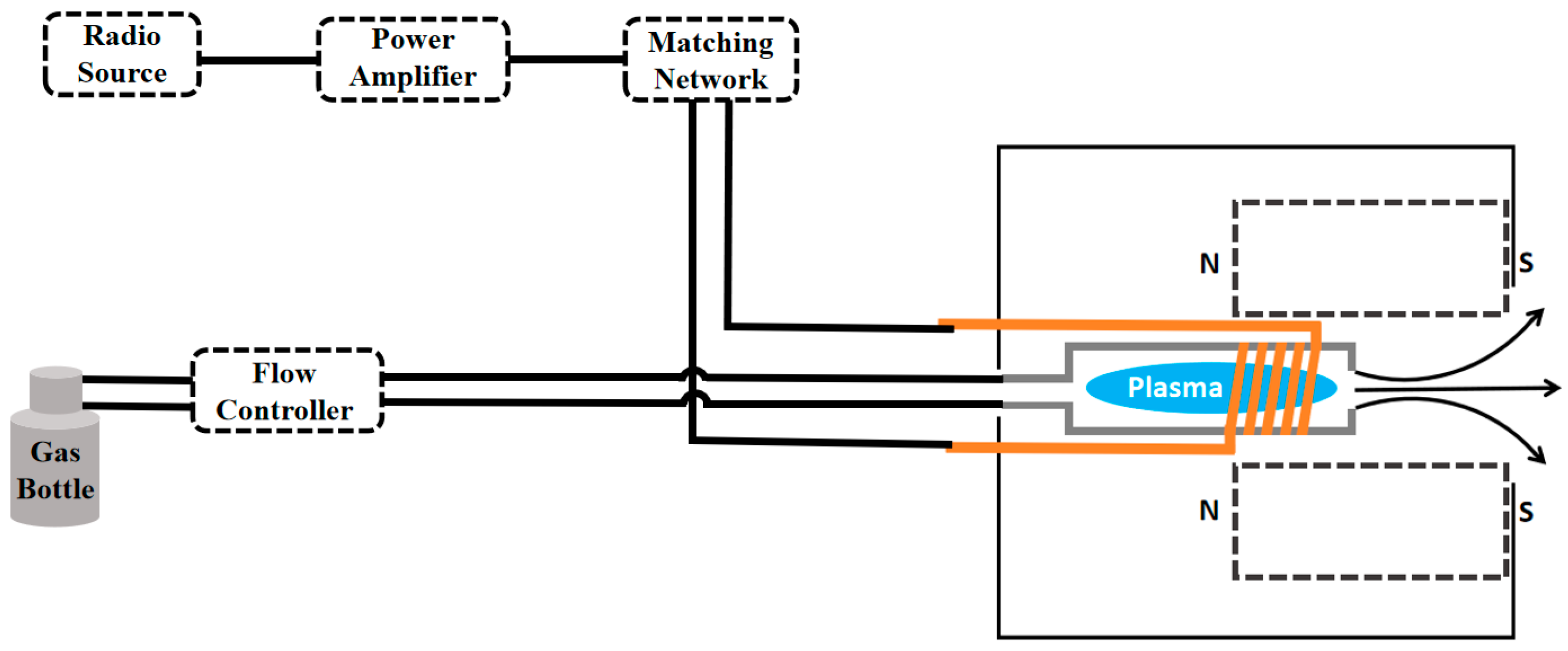
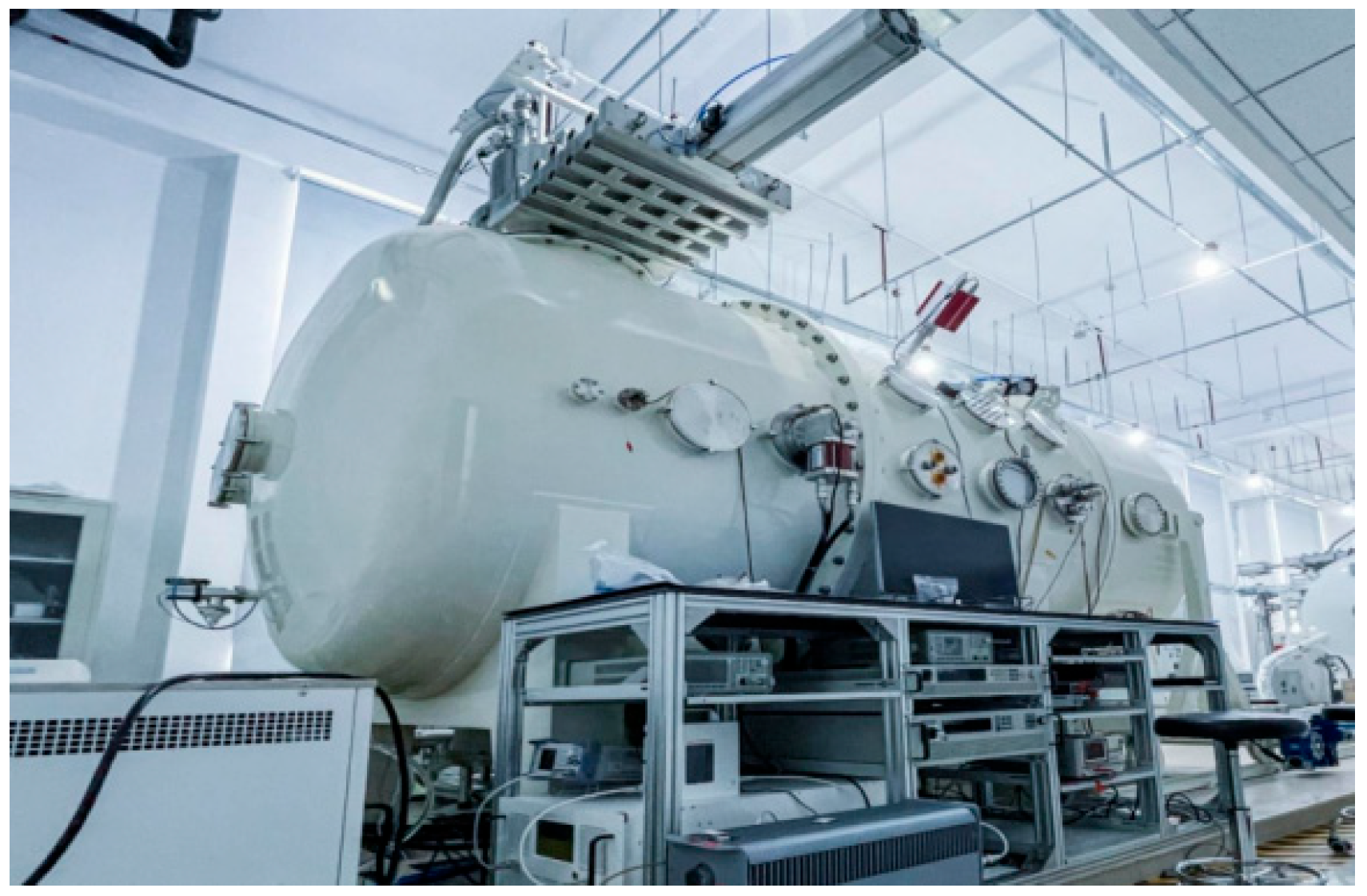
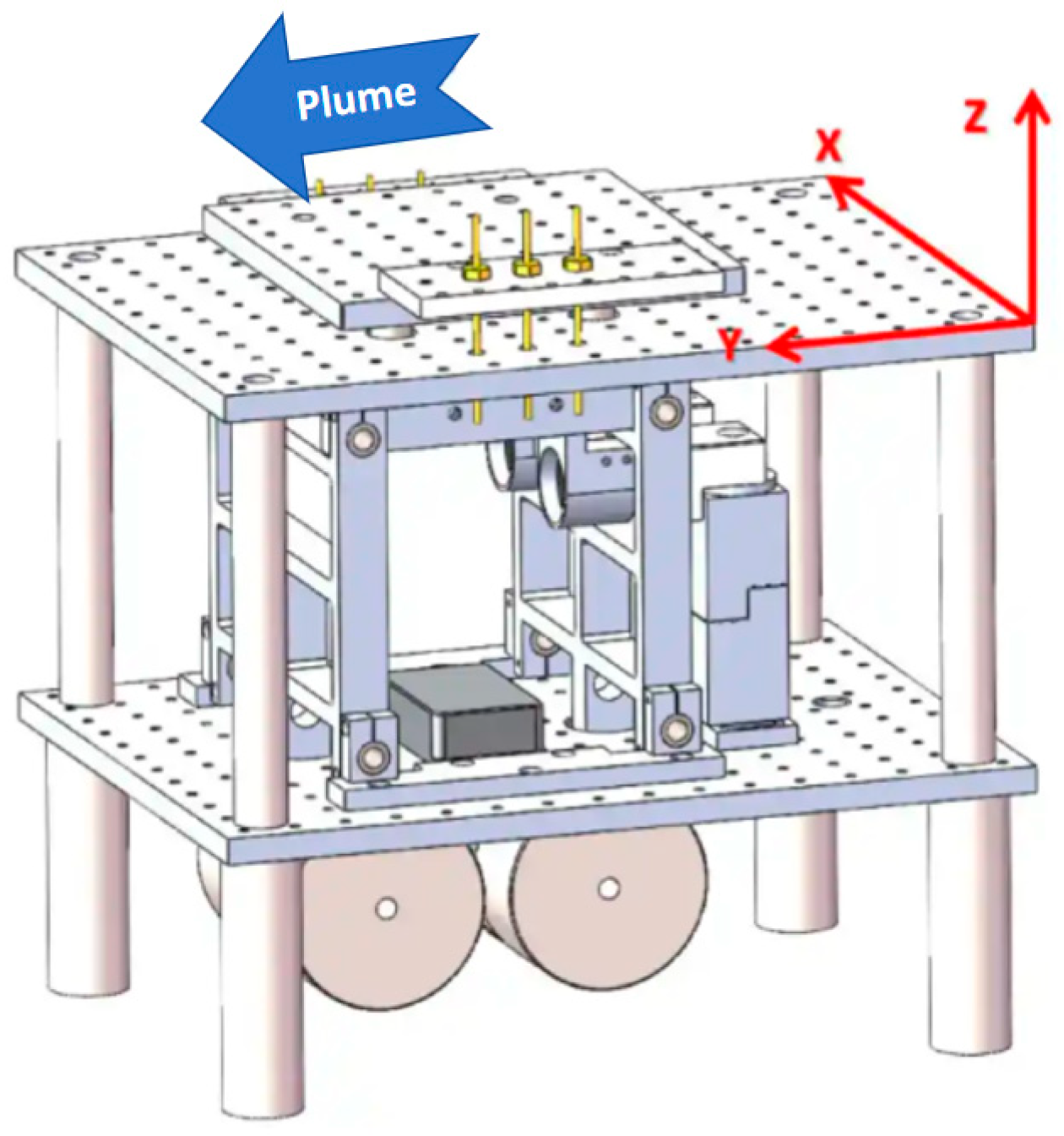
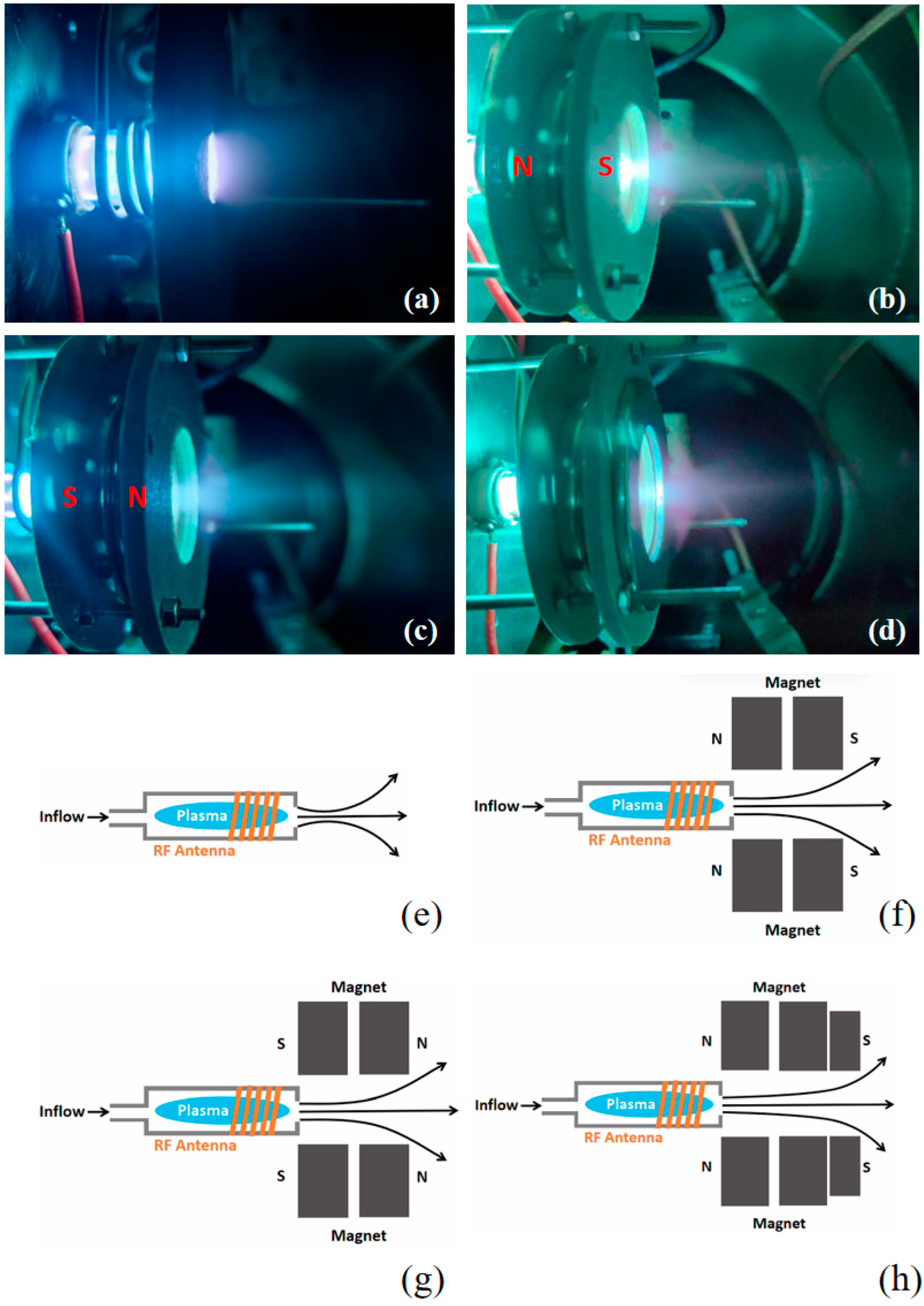
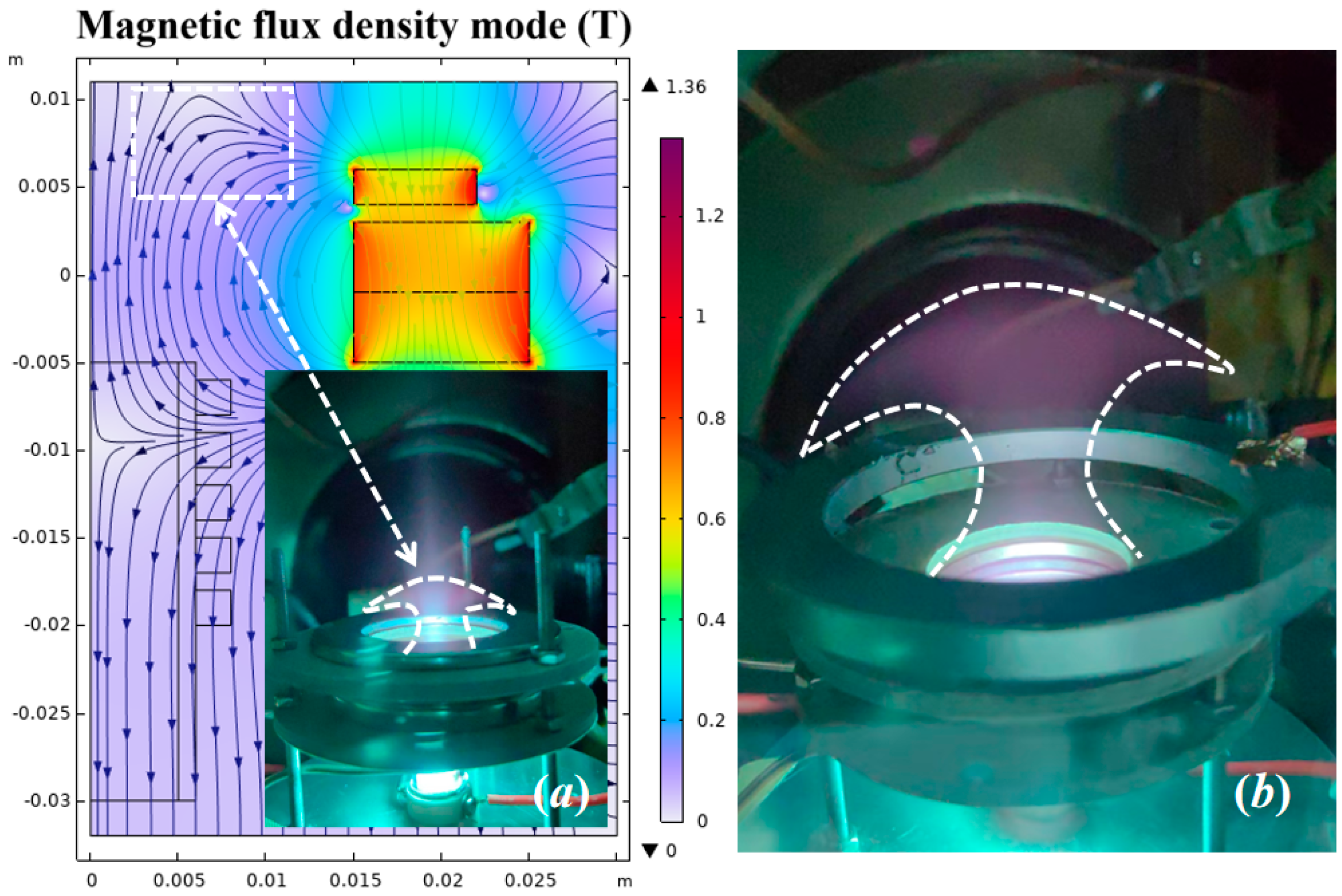

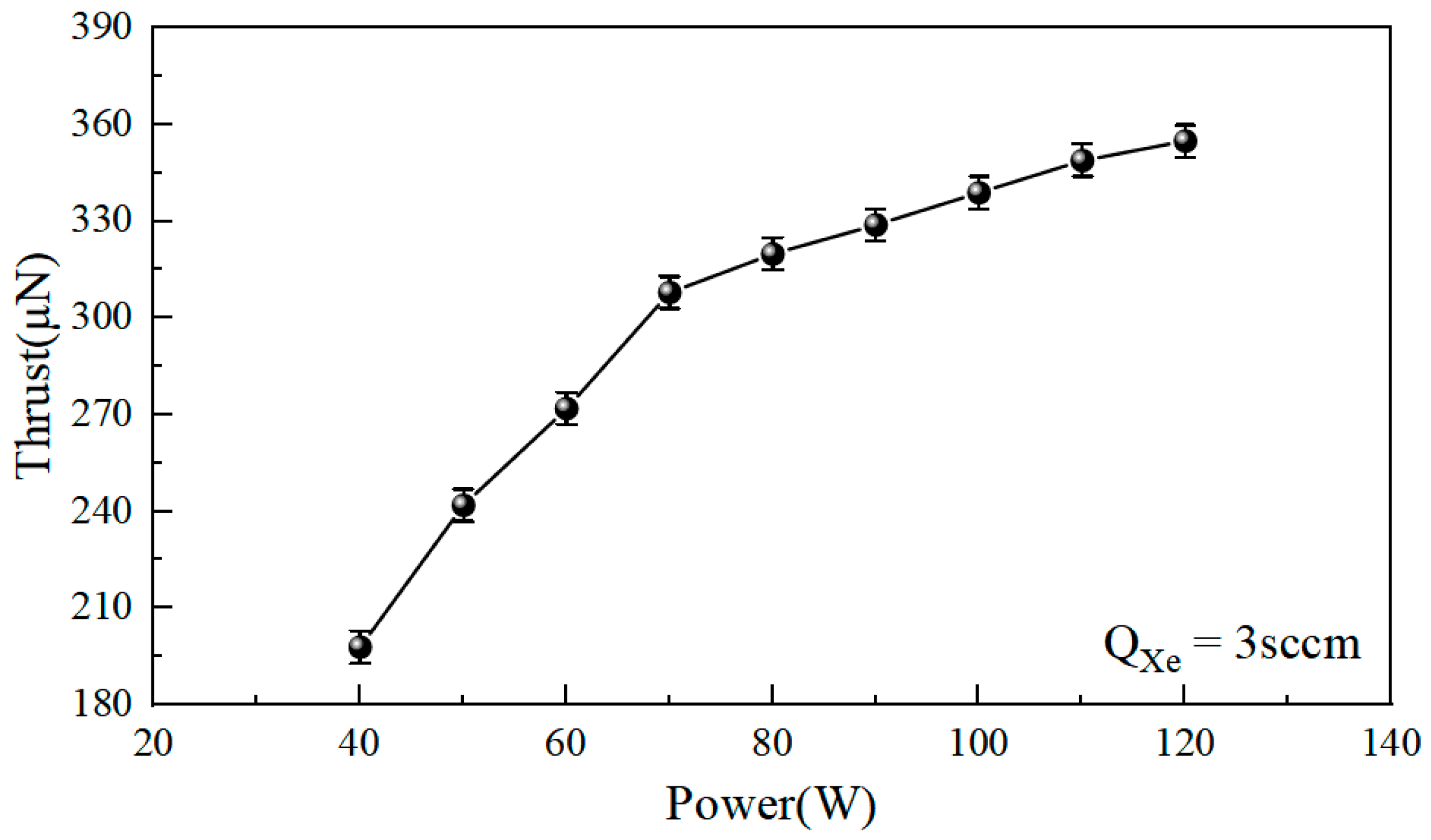
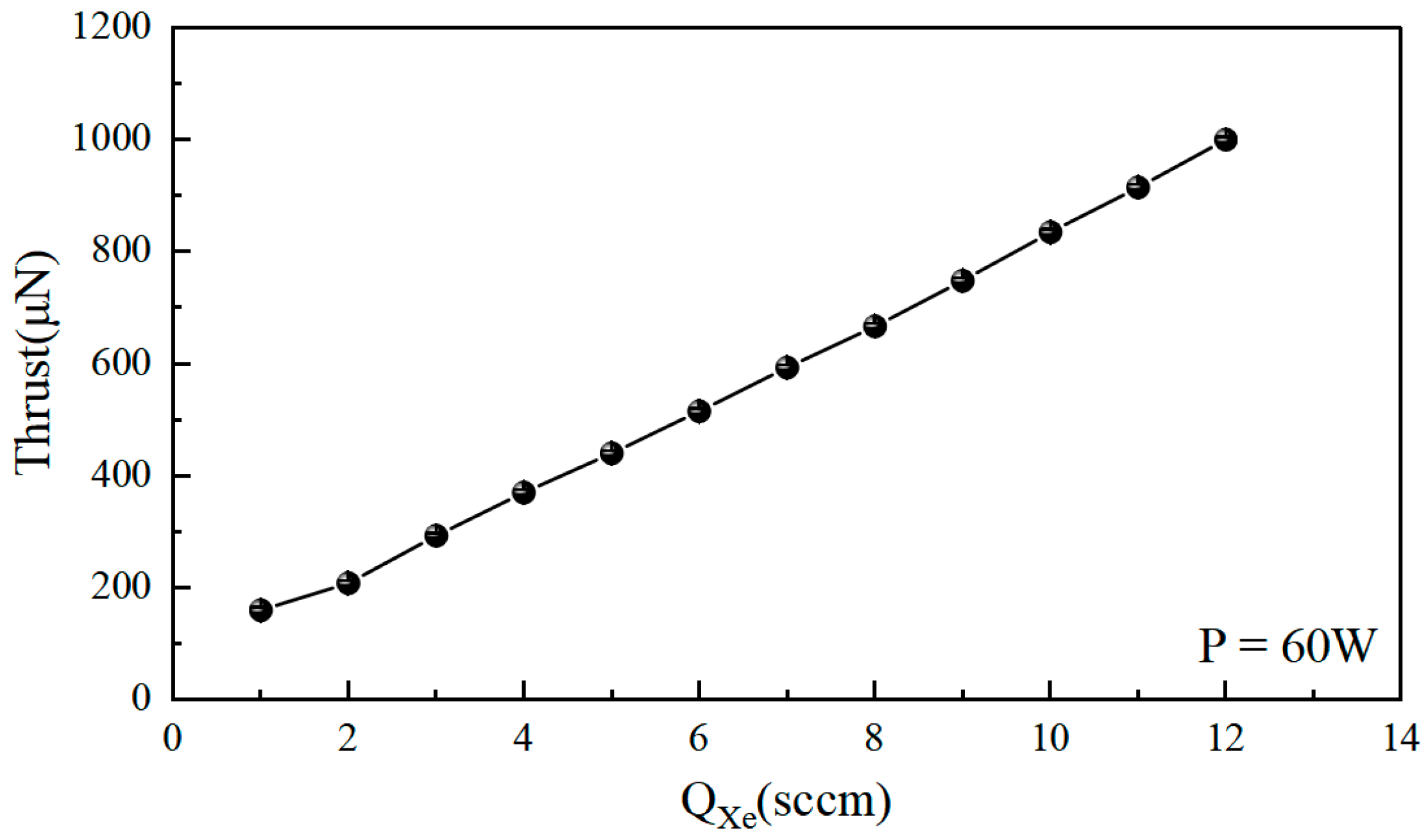
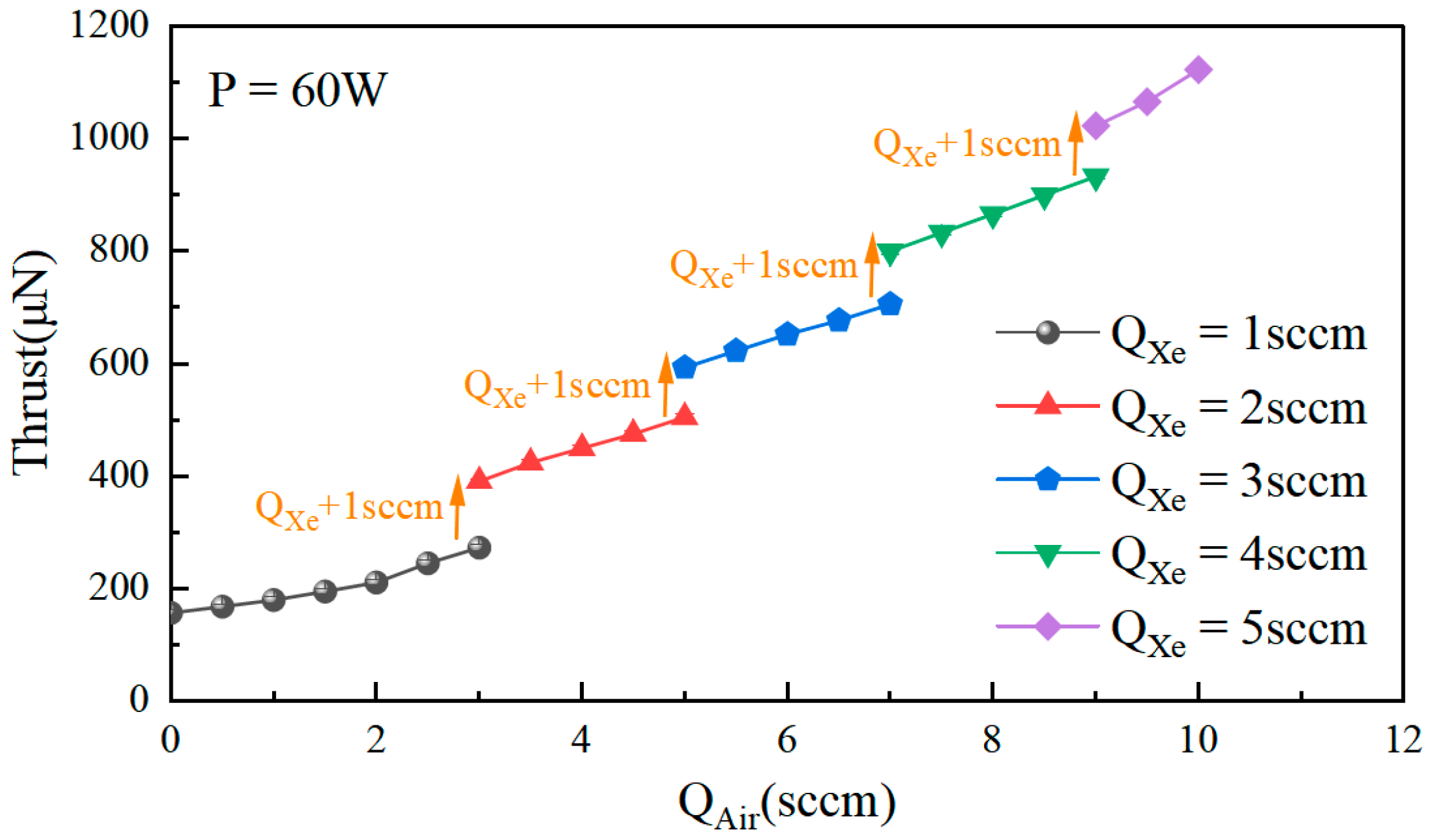
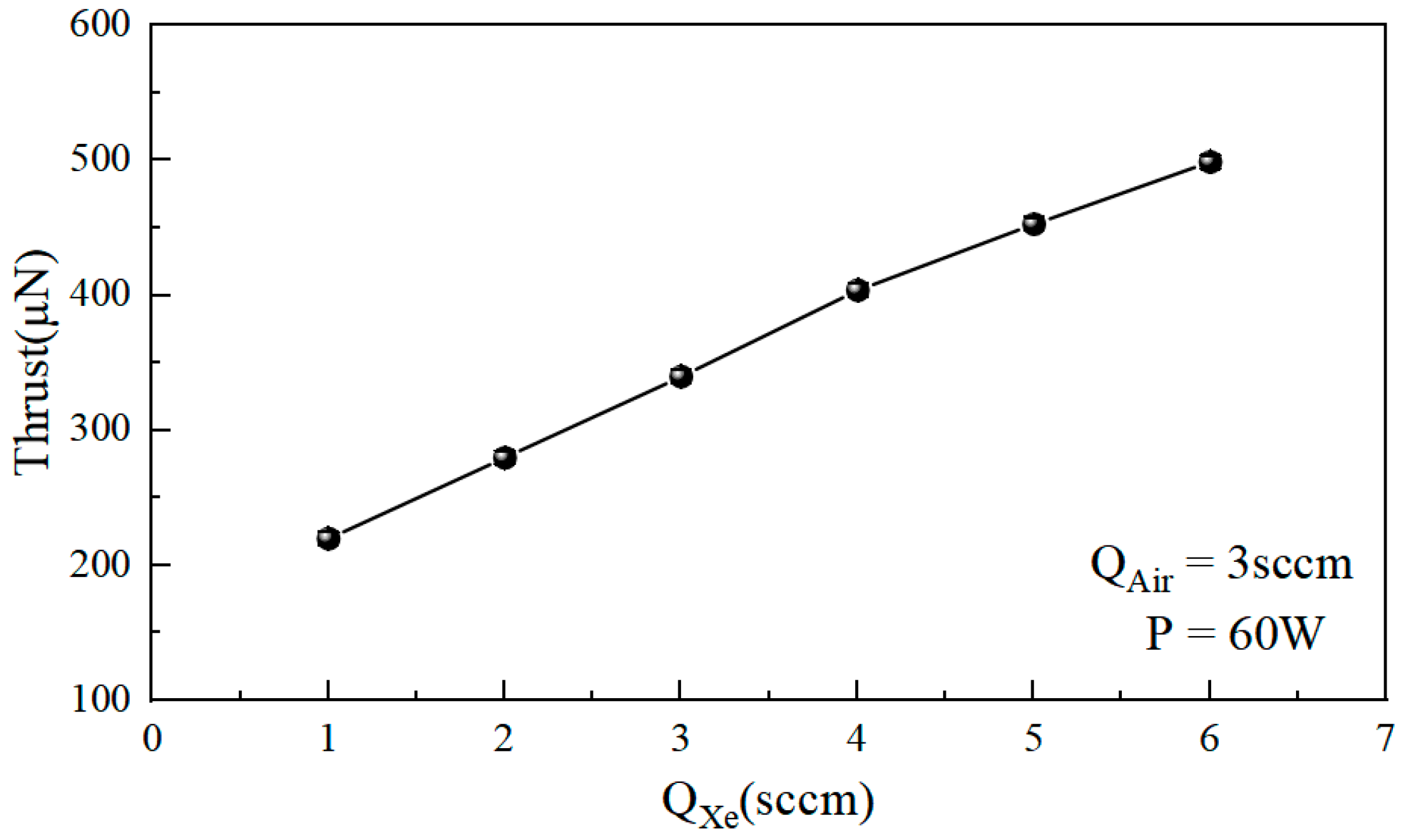
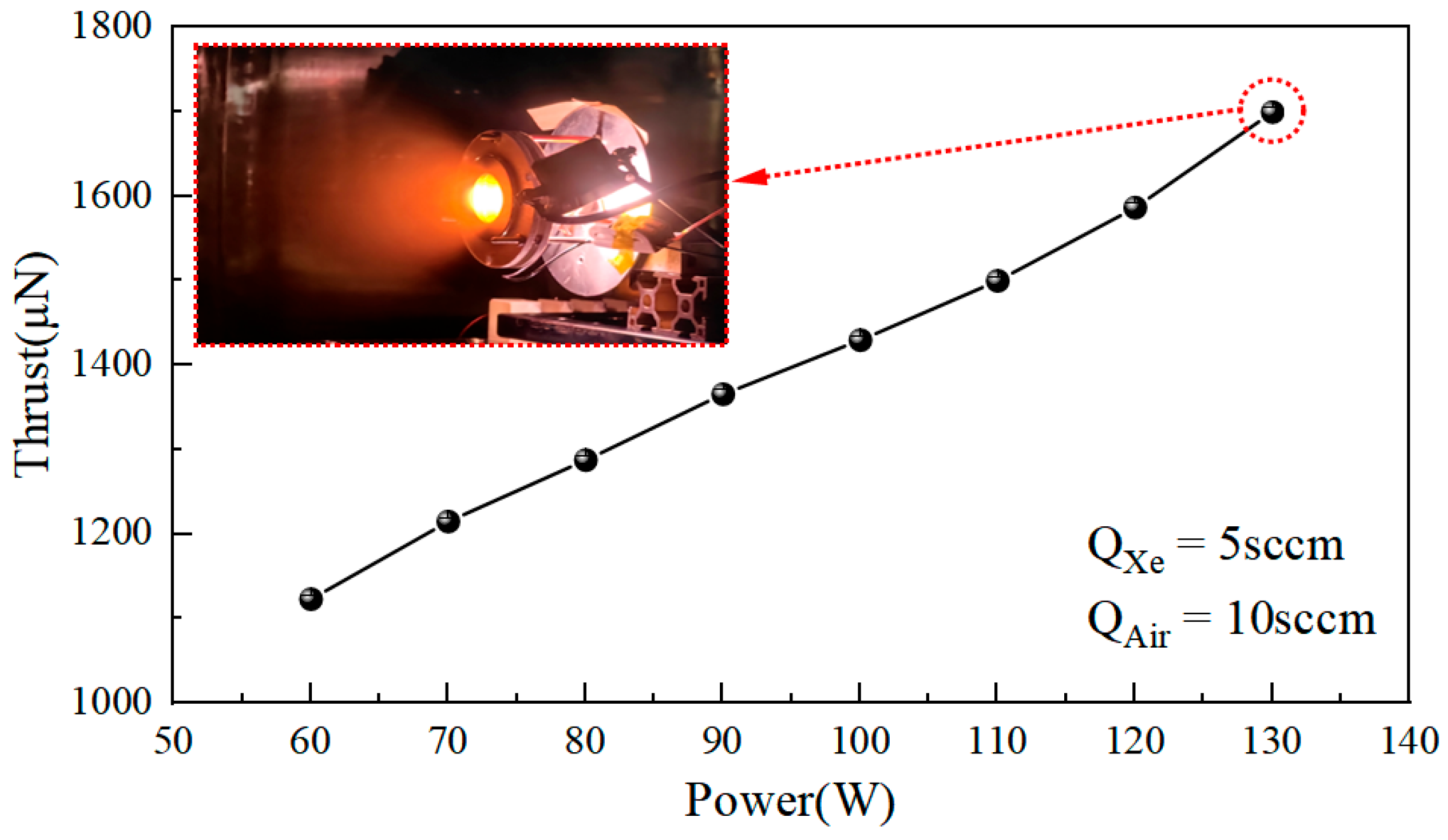
| Thrust Measurement Range | Measuring Error | Thrust Resolution |
|---|---|---|
| 0~2000 μN | ≤1% | 1 μN |
Disclaimer/Publisher’s Note: The statements, opinions and data contained in all publications are solely those of the individual author(s) and contributor(s) and not of MDPI and/or the editor(s). MDPI and/or the editor(s) disclaim responsibility for any injury to people or property resulting from any ideas, methods, instructions or products referred to in the content. |
© 2025 by the authors. Licensee MDPI, Basel, Switzerland. This article is an open access article distributed under the terms and conditions of the Creative Commons Attribution (CC BY) license (https://creativecommons.org/licenses/by/4.0/).
Share and Cite
Liu, J.; Ma, L.; He, J.; Geng, J.; Duan, L.; Kang, Q.; Xu, F. Optimization of Magnetic Nozzle Configuration and Hybrid Propellant for Radio-Frequency Plasma Micro-Thrusters in Very Low Earth Orbit Applications. Aerospace 2025, 12, 712. https://doi.org/10.3390/aerospace12080712
Liu J, Ma L, He J, Geng J, Duan L, Kang Q, Xu F. Optimization of Magnetic Nozzle Configuration and Hybrid Propellant for Radio-Frequency Plasma Micro-Thrusters in Very Low Earth Orbit Applications. Aerospace. 2025; 12(8):712. https://doi.org/10.3390/aerospace12080712
Chicago/Turabian StyleLiu, Jinhao, Longfei Ma, Jianwu He, Jinyue Geng, Li Duan, Qi Kang, and Feng Xu. 2025. "Optimization of Magnetic Nozzle Configuration and Hybrid Propellant for Radio-Frequency Plasma Micro-Thrusters in Very Low Earth Orbit Applications" Aerospace 12, no. 8: 712. https://doi.org/10.3390/aerospace12080712
APA StyleLiu, J., Ma, L., He, J., Geng, J., Duan, L., Kang, Q., & Xu, F. (2025). Optimization of Magnetic Nozzle Configuration and Hybrid Propellant for Radio-Frequency Plasma Micro-Thrusters in Very Low Earth Orbit Applications. Aerospace, 12(8), 712. https://doi.org/10.3390/aerospace12080712








